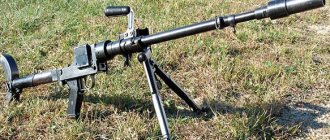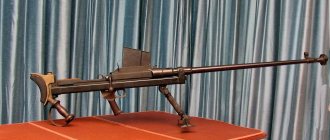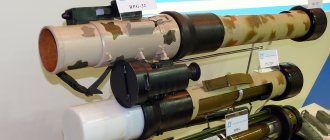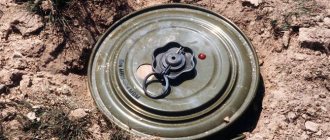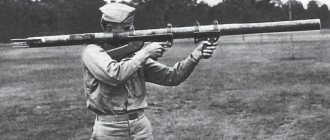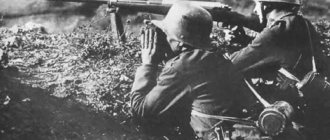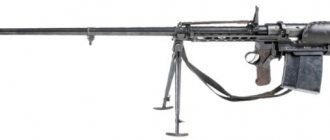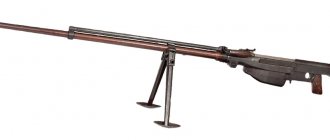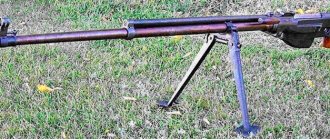PTR in service with the Wehrmacht
Two cartridges were created - 13x94 and 7.92x94. Both with flangeless bottle brass sleeves, differing only in the diameter of the barrel. Taking into account the need to lighten the design (it was planned that the gun would be operated by one person), the 7.92 mm caliber was chosen. The gun was developed by designer B. Bauer at (Gustloff Werke) in Suhl and received the index Pz.B.38 (Panzerbüchse 38 - “anti-tank gun model 1938”). The Pz.B.38 single-shot shotgun was equipped with a vertical wedge bolt, which was opened by moving the pistol grip forward and down, and to increase the rate of fire, it was equipped with a drum container with a capacity of 36 rounds, which was later replaced by two clips of 10 rounds each. To soften the recoil effect of a shot, the coupled barrel and bolt were moved back in a stamped box, made integral with the barrel casing and equipped with stiffening ribs - the recoil effect was thus extended over time. A conical flame arrester was placed on the barrel. The greater flatness of the bullet trajectory at ranges up to 400 m made it possible to install a constant sight. In total, about 1,600 copies were produced in 1939-1940.
Darth Vader armed with Pz.B.39 (from a Chinese toy soldier set)
After military tests, during modifications, the weight of the gun was reduced from 16.2 kg to 12.6 kg, and the modified gun was put into mass production under the designation Pz.B.39. It consisted of a barrel with a receiver, a bolt, a trigger frame with a pistol grip, a butt, and a bipod. The barrel was motionless, the active muzzle brake at its end absorbed up to 60% of the recoil energy. The bolt was closed on top with a flap that was automatically folded back when unlocked. The overall length of the anti-tank gun, the design of the bipod and “boosters” were almost similar to the PzB-38. The gun's permanent rack sight was designed for shooting at a distance of up to 400 m.
With less weight and greater maneuverability than its predecessor, the Pz.B.39 had more sensitive recoil. Its other characteristic drawback was the relatively difficult extraction of the cartridge case, and when unlocking the trigger frame it was necessary to exert great effort.
Pz.B.39
These guns used a developed 7.92x94 cartridge under the symbol “318” (full designation Patrone 318 SmK-Rs-L'spur or Patrone 318 SmKH-Rs-L'spur). Its bullet weighing 14.5 g accelerated in the barrel to 1180 m/s. The fairly high armor-piercing effect of the bullet, piercing 20-mm armor installed at an angle of 20° to the normal at a distance of 400 m, was ensured by a tungsten core. At a distance of 100 m, the Pz.B.39 penetrated 30 mm of armor, at 300 m - 25 mm. To increase the effectiveness of the impact on the crews of armored vehicles, an irritating composition (chloroacetophenone) was located in the bottom recess of the core. Later it turned out that the capsule could not get inside the tank. Bullets with chloroacetophenone are not widely used.
Production of the "318" cartridge continued until August 1942. A total of 9,417,000 rounds were fired. The Pz.B.39 PTRs themselves were produced (Rheinmetall-Borsig) in Germany and “Steyr” in Austria. A total of 39,232 units were produced.
In September 1939, the Wehrmacht had only 62 anti-tank rifles, and by June 1, 1941, the Wehrmacht already had 25,298 Pz.B.38 and Pz.B.39 rifles in service.
Armored vehicle armed with Pz.B.38/39
In 1940, it became obvious that the German army needed more powerful anti-tank infantry weapons. A competition was announced for a new PTR chambered for the same 7.92 cartridge “318”. New types of anti-tank rifles had a semi-automatic reloading system and an 8-round magazine. But none of the new developments had advantages over the PzB 39, and for this reason, none of the new developed anti-tank guns made it past the prototype stage.
In September 1941, the USSR planned to establish mass production of the Pz.B.39 (as a temporary measure due to a shortage of its own anti-tank rifles), however, design flaws were identified in the prototypes, and the anti-tank rifle had low armor penetration, which is why this idea was abandoned I had to refuse.
In the first half of the war, the Pz.B.39 was the main anti-tank defense weapon of the German infantry and was included in almost all units of the Wehrmacht ground forces. The infantry division was armed with 90 anti-tank rifles, the motorized division - 83, and the tank division - 57. The Pz.B.39 shotgun was used with some success at the initial stage of the war to combat tanks, wedges, and armored vehicles that had bulletproof armor. These PTRs were useless against most medium and heavy tanks of Germany's enemies. Due to the increasing share of such vehicles in the Allied forces, the Gz.B.39 anti-tank grenade launcher was developed on the basis of the Pz.B.39 for firing a cumulative grenade at heavily armored targets. When creating the grenade launcher, the barrel of the Pz.B.39 gun was shortened, and a mortar was screwed onto its muzzle, which was, in principle, similar to the mortar of the rifle grenade launcher installed on the Mauser 98 rifle and the 98k carbine.
Like the Pz.B.39 anti-tank rifle, the grenade launcher had a bipod that folded in the stowed position and a metal butt that rotated down and forward. To carry the grenade launcher, a handle attached to the weapon was used. The G.Pzgr.61 mm cumulative anti-tank grenade was designed especially for the Gz.B.39. The good aerodynamic shape of its body contributed to increased combat accuracy, and an increase in the diameter of the cumulative funnel significantly increased the armor-piercing ability of the grenade - up to 80 mm at distances of 75-150 m, although the shooting accuracy turned out to be insufficient. Precision shooting at moving targets was carried out at ranges of up to 75 m, and at stationary targets - up to 125 m. In general, the new grenade brought this weapon into the category of quite serious opponents for medium tanks of the Allies produced in 1941-43. Along with the G.Pzgr.61 mm, the Gz.B.39 grenade launcher could also fire the G.Pzgr.46 mm cumulative armor-piercing grenade from the Gw.Gr.Ger.42 rifle grenade launcher. It was shot with a special blank cartridge with an increased powder charge Treibpatrone 318, created on the basis of the 7.92 mm “318” cartridge for PTR.
For quite a long time, the Gz.B.39 remained the most powerful anti-tank weapon of the German infantry. And yet, Germany’s main opponents began to have increasingly thick-skinned tanks, and the Germans themselves, at the end of 1943, began serial production of rocket-propelled anti-tank grenade launchers. The era of German anti-tank rifles has come to an end.
The Germans also had in their arsenal the so-called heavy 20-mm anti-tank rifle PzB-41 on a gun carriage. But it weighed 223 kg and was more of a small-caliber gun than an anti-tank rifle.
Czechoslovak PTR MSS.41
14,5
The USSR actively studied the experience of the past war and the development of foreign weapons. The idea to create your own PTR arose back in the 30s. But we initially followed the “Finnish” path, assuming the caliber of the gun was 20-25 mm. This made such a bandura completely unliftable and dubious against the background of a 45-mm gun. The team of M. N. Blum, S. A. Korovin, S. V. Vladimirov presented as many as 15 versions of the gun, but all of them did not suit the military.
Various types of cartridge 14.5x114 mm.
However, we already had a new and very successful cartridge ready, which is still in use today - 14.5x144 mm. The first "pancake" for it - the Rukavishnikov PTR - turned out to be more successful, but after the production of 50 guns, production was stopped. This step - to do this with a good example of a weapon before the war - was a big mistake. The opinion of V.G. Grabin, a talented gun designer who was a categorical opponent of the PTR, played a lot.
PTR made in Czechoslovakia
Czechoslovakian gunsmiths also worked for the benefit of Nazi Germany. They also had their own pre-war developments. In close cooperation with specialists from the SS Weapons Academy (SS-Waffenakademie), the Czech company Waffenwerke Brunn (before the occupation of Czechoslovakia - Zbrojovka Brno) designed in 1940-41. PTR Pz.BMSS.41 (or MSS-41) chambered for the above-mentioned armor-piercing cartridge “318” with a caliber of 7.92 mm. Basically, these guns were in service with the SS troops.
An interesting feature of this sample was that it was made according to the “bullpup” scheme. A characteristic feature of the bullpup is that the firing mechanism and magazine are located in the butt behind the trigger. Thanks to this arrangement, it is possible to increase the length of the barrel without increasing the overall length and weight of the weapon, which has a positive effect on range and accuracy. In all likelihood, it was thanks to the M.SS.41 that the bullpup design became quite popular among small arms designers. In addition, these anti-tank rifles were first used as large-caliber sniper rifles: the SS troops had special teams armed with MSS-41 with optical sights, whose main task was to destroy firing points from long distances. The latter meant machine-gun embrasures of bunkers and bunkers, sniper positions, crews of machine guns, mortars and light field artillery.
During reloading, the shooter, just like in the German PzB.39, did not need to remove his hands from the pistol grip, since he manually moved the barrel back and forth using this handle. The barrel was locked by a coupling on which a pistol grip was mounted, with an assembled trigger mechanism and safety catch. This gun did not have a bolt in the usual sense. The bolt was part of a fixed butt plate and was engaged with the barrel by a coupling mounted on the barrel with a threaded fit. The clutch rotated when the pistol grip of the fire control moved forward and upward. Then, as the handle moved forward, the barrel began to move. A perforated casing served as a guide for the barrel with the coupling. During the reverse movement, the barrel rested on the cartridge, held by the ejector hook. By turning the pistol fire control handle down, the barrel was locked with the bolt. The trigger mechanism was mounted in a pistol grip, on the left side of which there was a safety lever. The sighting devices consisted of folding front sights and a sight designed for shooting at a range of 500 m. The location of the barrel, receiver and butt on the same axis, a spring shock absorber covered with rubber shoulder rest (which was also a mainspring), and in addition, the use of a single-chamber muzzle brake closed type minimized recoil when firing. The cartridges were fed from a removable box magazine with a capacity of 5 - 10 rounds. The magazines were attached to the bottom on the left side of the receiver. The practical rate of fire reached 20 rounds/min.
Swiss PTR S18-1000
This gun was more compact than the Pz.B.39, but its cost was higher, and armor penetration was poor for both models.
After the production of several thousand PzB M.SS.41, their production by Waffenwerke Brunn was discontinued.
In addition to the 7.92 mm PzB M.SS.41, SS-Waffenakademie specialists also designed its 15 mm analog Pz.B.42 (Czechoslovak designation W/15). The 15-mm single-shot anti-tank rifle Pz.B.42 was an enlarged and slightly modified version of the Pz.BMSS.41 anti-tank rifle, but in a single-shot version. The production of the gun was carried out by the same company Waffenwerke Brunn. Locking and unlocking of the bolt was carried out due to the movement of the movable barrel. When the barrel moved forward, it opened and the spent cartridge was extracted, and when the barrel moved back, the cartridge fell into the chamber. When the barrel was turned to the left, it was locked, and the weapon was ready to fire. In contrast to the single-chamber muzzle brake, the Pz.B.42 PTR was equipped with a more effective 3-chamber muzzle brake, which significantly reduced recoil when fired. A folding bipod was mounted at the center of gravity of the weapon. The shoulder rest is spring-loaded. The rack-mount type folding sight was designed for fixed firing ranges - 300, 600 and 800 m, although the effective firing range did not exceed 300 m. The new gun was designed to use the 15x104 Brno heavy machine gun cartridge from the ZB 60 heavy machine gun. a much more powerful cartridge, the PzB.42 had approximately the same combat characteristics as the Pz.BMSS.41. With an initial bullet speed of 900 m/s, its normal armor penetration was 28 mm at a distance of 100 m, and 18 mm at 300 m. The total weight did not exceed 18.5 kg. The practical rate of fire reached 10-12 rounds/min. When changing positions on the battlefield, the Pz.B.42 anti-tank rifle was transported by a carrying handle, and on the march, the weapon was attached behind the shooter’s back on a special carrying device with straps, similar to a backpack.
Switzerland
The German allies armed themselves with another no less curious model. And this seemingly formidable weapon was produced in neutral Switzerland. Solothurn Waffenfabrik AG is a Swiss branch of the German concern Rheinmetall-Borsig, which arose due to the restrictions imposed by the Treaty of Versailles. Unlike its German comrades, the Swiss branch decided to play big back in the early 30s.
View of the optics and PTR store Solothurn
Namely, to use developments from the field of designing aircraft guns to create anti-tank missiles. Heinrich Erhard, director of the Düsseldorf branch of Rheinmetall-Borsig, has been developing aircraft guns since the end of WWI. Engineers Rheinmetal - Gerlach and Rakula took the Erhard system with recoil and short stroke as a basis, modified it by introducing the Stange locking system and created a family of universal automatic guns.
Among this family already in 1932. The Solothurn S18-100 anti-tank gun also appeared. In fact, this weapon goes somewhat beyond the scope of classic anti-tank rifles since it was created not on the basis of a rifle, or even on the basis of a heavy machine gun, but on the basis of an air cannon. Hence we have a large caliber of 20x105mm and a large weight for a portable weapon - more than 40kg.
Hot Italian guys in North Africa with Swiss Solothurn
The 20x105B cartridge (or rather even the projectile) was soon (1934) replaced by the more powerful 20x138B, the barrel was lengthened and the total weight without ammunition exceeded 50 kg. The new model was designated Solothurn S18-1000, and later S18-1100. The new models also had the ability to fire automatically. Despite its high penetrating ability and formidable caliber, this weapon did not become any serious tank destroyer.
The Swiss half-cannon was mainly used by Hungarian, Italian, Bulgarian and Finnish units. The Wehrmacht used it quite limitedly under the designation PzB.41(s) and showed low effectiveness against medium T-34 tanks and heavy KVs.
Solothurn S18-1000 kit
Between the wars
The Germans' experience did not go unnoticed. Perhaps the most interesting example of the development of such weapons was the project of the English captain Boyce. The experience of the Spanish Civil War showed that despite the presence of artillery and machine guns of various types, infantry required light and less noticeable anti-tank weapons. And taking into account the fact that at that time powerful PTR cartridges still perfectly penetrated tanks with bulletproof armor, of which there were the majority, the conclusion was obvious.
PTR Boyce
Boyce developed a gun, which he called the Elephant gun, but it went down in history under the name of the captain himself. Boyce abandoned the 12.7 mm cartridge for the Vickers machine gun and chose the most powerful 13.9 mm cartridge. The Boyce turned out to be quite successful: the top-mounted 5-round magazine and comfortable ergonomics were perfect for the shooter. But the armor penetration was not very good. It was necessary to shoot from 100 meters, otherwise the effect was sharply reduced.
Finnish Lahti, you can estimate the size
Separately, we can note the use of “Boys” by the Finns during the Soviet-Finnish War. The Boyce tandem with their own Lahti anti-tank rifle at a monstrous 20 millimeters (often this gun could injure the shooter) performed well. The guns were used for shooting both at vehicles and at embrasures, fortifications, and were used as an anti-sniper option.
German PzB 39
Research was also carried out in Poland. Their famous “secret” Ur gun (ostensibly for shipment to Uruguay) performed well in the fight against German light tanks and armored cars in 1939. And the Germans also had their own version of the PzB-38 “Panzerbühse”. Both guns eventually served in the Wehrmacht, but their caliber 7.92x108x94 left them no chance in the further course of the war.
PTRS device
The gun was equipped with an automatic gas engine with gas exhaust through a transverse hole in the barrel wall, and an open gas chamber mounted at the bottom of the barrel. The gas piston stroke is short. The general design and bore are generally similar to the PTRD, which is logically explained by the standardized ammunition.
Simonov's anti-tank rifle had the barrel locked with the bolt frame skewed downward. The bolt stem, complemented by a handle, locked and unlocked the channel. The “reloading mechanism” was the name given to the weapon’s automatic parts, namely a three-mode gas regulator, a rod, a piston, a tube and a pusher with a spring. After the shot, the pusher moved backward under the pressure of the powder gases, transmitted the impulse to the bolt stem, and itself returned forward. Under the action of the bolt stem moving backward, the frame unlocked the barrel, after which the entire bolt moved backward. The spent cartridge case was removed by the ejector and reflected upward by a special protrusion. When the cartridges were used up, the bolt was set to stop, mounted in the receiver.
The trigger is installed on the trigger guard. The non-automatic safety catch blocked the trigger when the flag was turned back. The permanent magazine (lever type feeder) is attached to the bottom of the receiver, the magazine cover latch is located on the trigger guard. The magazine is loaded with a pack (clip) of 5 rounds, placed in a checkerboard pattern.
Simonov's 1941 anti-tank rifle is 4 kg heavier than Degtyarev's model, due to the multi-charge automatic rifle (21 kg without cartridges). Sight shooting – 1500 m.
The barrel length of both PTRs is the same - 1350 mm, as well as armor penetration (average indicators): at a killing distance of 300 m, the B-32 bullet penetrated 21 mm of armor, and the BS-41 bullet - 35 mm.
Pre-armor action
It is no less important than armor-piercing. Having penetrated the armor, a bullet, solid projectile or armor-piercing core causes damage due to fragmentation and incendiary action. Their highly heated fragments, together with fragments of armor, penetrate inside the vehicle at high speed, affecting the crew, mechanisms, ammunition, tanks, power pipelines, lubrication systems, and are capable of igniting fuels and lubricants.
To increase efficiency, cartridges with armor-piercing incendiary and armor-piercing tracer bullets were used, which had armor-piercing and armor-piercing effects. The high initial velocity of the bullet was achieved by using a powerful cartridge and a large relative barrel length (from 90 to 150 mm).
Ammunition
A few words should be said about the anti-tank rifle cartridge and its damaging effect. For PTR, ammunition of a larger caliber was developed than traditional types of small arms. In domestic samples, armor-piercing bullets of 14.5 mm caliber were used. Its kinetic energy was enough to penetrate 30 mm armor or damage weakly protected armored vehicles.
The action of an armor-piercing bullet (projectile) on a target consists of an armor-piercing (impact) action and a damaging action behind the armor (behind the armor action). The action of PTR bullets is based on their kinetic effect on armor and its penetration by the body or solid core. The higher the kinetic energy of the projectile (bullet) thrown at the moment of collision with the armor, the higher the thickness of the penetration protection. Due to this energy, work is done to pierce the metal.
Conclusion
The first anti-tank rifles appeared along with the tanks themselves - in the First World War
Before the start of the Second World War, both Germany and the USSR did not realize their obvious importance, giving priority to other types of weapons. However, the very first months of the clash between infantry units and the Wehrmacht tank armada showed how erroneous the underestimation of mobile, cheap, effective anti-tank rifles was.
In the 21st century, the “good old” anti-tank rifle still remains in demand, the modern purpose of which is fundamentally different from that of the Great Patriotic War models. Considering that tanks can withstand several RPG hits, a classic anti-tank rifle is unlikely to hit an armored vehicle. In fact, anti-tank rifles have evolved into a class of “heavy” universal sniper rifles, in the image of which the outlines of anti-tank rifles can be discerned. They are designed to hit drones, manpower at a considerable distance, radars, missile launchers, protected firing points, communications and control equipment, unarmored and lightly armored mobile equipment and even hovering helicopters.
At first, they were carried out mainly with 12.7 mm ammunition from heavy machine guns. For example, the American M82A1 “Barrett”, M87 and M93 “McMillan”, the British AW50, the French “Hecate II”, the Russian ASVK and OSV-96. But in the 2000s, within the families of large-caliber cartridges 12.7x99 (.50 Browning) and 12.7x108, special “sniper” cartridges appeared. Such cartridges were included, for example, in the same Russian 12.7-mm sniper systems OSV-96 and ASVK (6S8), and the American M107. Rifles chambered for more powerful cartridges are also presented: the Hungarian Cheetah (14.5 mm), the South African NTW (20 mm), the American M-109 (25 mm) and others. The start taken at the beginning of the 20th century continues!
"Tankgewer" against steel monsters
The First World War became the theater of baptism of fire for a new weapon - tanks. By the end of the war, avalanches from hundreds of armored vehicles rolled into German positions. Germany, which did not pay enough attention to the creation of tanks, took the path of countering the new threat through the creation of anti-tank weapons. An anti-tank gun, factory-made grenade clusters, and a Tankgewer M1918 anti-tank rifle, or Mauser T-gewer.
Tankgewehr M1918
This is a heavy (almost 18 kg) rifle chambered for the new 13 mm machine gun cartridge. The machine gun itself, however, did not have time to be produced en masse, but the rifle turned out to be easy to manufacture and quickly took root among the troops. Each company had such a deadly “club”, and in total, before the end of the war, the German infantry received more than 15 thousand of these rifles. And now the armor of the tanks, which had previously been invulnerable to gunfire, was hit by serious bullets that could penetrate any tank of that time at a distance of 300 meters. This was quite enough for the trench conditions of war, but the armor effect of the bullet, if it did not hit the crew, turned out to be low. The war ended, and gunsmiths did not have time to develop a new threat to tanks. But a new big war was approaching.
High efficiency
The need for these weapons was so high that sometimes guns went straight from the factory workshop to the front lines. The first batch was sent to the 16th Army, to General Rokossovsky, who was defending Moscow northwest of the Soviet capital, in the Volokolamsk direction. The application experience was a success: on the morning of November 16, 1941, near the settlements of Shiryaevo and Petelino, soldiers of the 1075th Infantry Regiment of the Eighth Guards Division holding the front section shot at a group of German tanks from 150-200 m, 2 of which burned completely.
The role that Degtyarev’s (and Simonov’s) anti-tank rifle played in the defense of the Soviet capital is evidenced by the fact that V. Degtyarev himself and many factory workers who organized the production of weapons lethal to armored vehicles were awarded the medal “For the Defense of Moscow.”
As a result of the combat use of rifle systems, designers made significant improvements to their mechanics. The production of guns increased every day. If in 1941 17,688 units of the V. Degtyarev system and only 77 units of the S. Simonov system were manufactured, then in 1942 the number of guns increased respectively to 184,800 and 63,308 units.
Damaging armor effect
The WWII anti-tank rifle was very effective. Of course, with its help it was impossible to overcome the armor protection of the turret and hull of medium and heavy tanks, but any vehicle has vulnerable areas, which were hit by experienced shooters. The armor only protects the engine, fuel tanks, mechanisms, weapons, ammunition and crew of the combat vehicle, which, in fact, need to be hit. In addition, anti-tank rifles were used against any equipment, including lightly armored ones.
The action of the damaging element and armor on each other is mutual, the same energy is spent on the destruction of the bullet itself. Therefore, the shape and lateral load of the projectile, the strength of its material and the quality of the armor itself are also of decisive importance. Since the kinetic energy formula includes mass in the first power and speed in the second, the final velocity of the ammunition is of particular importance.
Actually, it is the speed of the bullet and the angle of its meeting with the armored barrier that are the most important factors determining the armor-piercing effect. Increasing the speed is preferable to increasing the mass of the projectile also from the point of view of accuracy:
- the flatness of the trajectory increases, and hence the range of a direct shot at a “tank” type target, when shooting is carried out on one sight setting;
- The flight time of the bullet to the target also decreases, along with it the amount of drift by the side wind and the movement of the target during the time from the start of the shot to the expected meeting of the striking element with the target.
On the other hand, mass is directly related to lateral load, so the armor-piercing core must still have a high density.
Large caliber sniper rifles
Main article: Large-caliber sniper rifle
In the early 1980s, the development of large-caliber sniper rifles began in a number of countries. Compared to small arms, large-caliber rifles are characterized by a greater aiming, lethal and effective firing range.
Fire training of American snipers, Barrett M82A1 rifle
Large-caliber sniper rifles are used to disable lightly armored and unarmored vehicles (vehicles on the ground and low-flying airplanes and helicopters, etc.), reconnaissance, control and communications equipment (radar antennas, satellite communications, etc.), protected firing points (shooting on embrasures and observation devices of bunkers, etc.), destruction of unexploded mines and aerial bombs. Also, large-caliber sniper rifles are used to combat enemy snipers.
